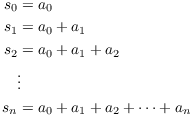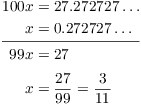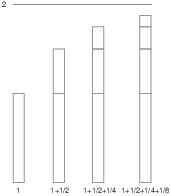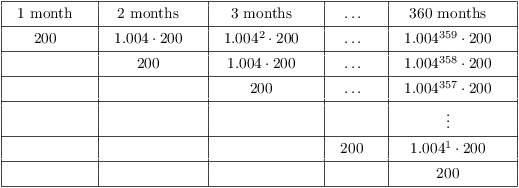An infinite series is a sum
![]()
I can use summation notation if I don't want to write the terms out:
![]()
For example,
![]()
![]()
![]()
Addition is not defined for an infinite collection of numbers. I have
to define what I mean by the sum of an
infinite series like those above. To do this, I'll look at the sequence of partial sums. For ![]() , the partial sums are
, the partial sums are

To say that the sum of the series is S means that the sequence of partial sums converges to S:
![]()
The notation for this is
![]()
It is often difficult to compute the sum of an infinite series exactly. However, you can often tell that a series converges without knowing what it converges to. If necessary, a computer can be used to approximate the sum of a convergent series.
Some infinite series are already familiar to you. For example, the
decimal representation of a real number is a convergent infinite
series. Here is the number ![]() :
:
![]()
It's an infinite non-repeating decimal.
Repeating decimals represent rational numbers. I'll show by example
how to convert a repeating decimal to a rational fraction. Consider
![]() . Set
. Set ![]() . Then
. Then

Definition. A geometric series is a series of the form
![]()
The picture below shows the partial sums of the geometric series
![]()
Notice that the partial sums seem to approach 2.

To find a formula for the sum of a geometric series, I'll start by
computing the ![]() partial sum. By long division,
partial sum. By long division,
![]()
(This will make sense provided that ![]() .)
.)
Multiply by a, then move the last term on the right to the left:
![]()
This gives a formula for the sum of a finite geometric series.
For instance,
![]()
What about the infinite series
![]()
The series converges if the limit of ![]() partial sum
exists. I need to compute
partial sum
exists. I need to compute
![]()
By a result on geometric sequences,
![]()
Hence,
![]()
For instance,

![]()
What about something like
![]()
Well, this is

Example. (Retirement) $200 is deposited each
month and collects ![]() annual interest, compounded monthly. How
much is in the account after 30 years?
annual interest, compounded monthly. How
much is in the account after 30 years?
Note that 30 years is 360 months.
![]() annual interest, compounded monthly, means that each
month the amount in the account earns
annual interest, compounded monthly, means that each
month the amount in the account earns ![]() interest. This means that the amount in the account is multiplied by
1.004 each month.
interest. This means that the amount in the account is multiplied by
1.004 each month.
The table below tracks each monthly deposit. The first row represents the first $200 deposited, the second row the second $200 deposited, and so on.

The total amount in the account is the sum of the numbers in the last column, which is
![]()
By comparison, with no interest --- e.g. if you put $200 a month under your mattress --- you'd only have $72000 after 30 years.
At the same time, this is a rather sobering conclusion. Many people
would find it a challenge to put away $200 a month toward retirement.
This problem shows that doing so and assuming a moderate interest
rate produces a significant total --- but definitely not enough to
retire on!![]()
The harmonic series is the series
![]()
It is an important example of a divergent series.
Here's an easy way to convince yourself that it diverges. Write down the terms of the series, and underneath the terms of a new series. The terms of the new series are all less than or equal to the terms of the harmonic series:

Do you see the pattern? Next, you'll take the 8 terms of the harmonic
series from ![]() to
to ![]() and write
and write
![]() under each of them, then the next 16 terms of the
harmonic series, and so on.
under each of them, then the next 16 terms of the
harmonic series, and so on.
Consider the series on the bottom. The first two terms are both ![]() . After that, the sum of the next two terms is is
. After that, the sum of the next two terms is is
![]() . After that, the
sum of the next four terms is
. After that, the
sum of the next four terms is
![]()
And so on. So the series on the bottom is an infinite sum of ![]() 's, which goes to infinity. Since term-by-term the
harmonic series is at least as big, it must diverge to infinity as
well.
's, which goes to infinity. Since term-by-term the
harmonic series is at least as big, it must diverge to infinity as
well.
The harmonic series is a member of a family of series called p-series. Here the the facts about convergence and divergence of p-series.
Proposition. Let ![]() be a p-series, where
be a p-series, where ![]() .
.
(a) If ![]() , the series converges.
, the series converges.
(b) If ![]() , the series diverges.
, the series diverges.
The harmonic series is the case ![]() . For example,
. For example,
![]()
![]()
![]()
I'll prove the result above using the Integral Test, which I'll discuss later.
If ![]() , the sum of the p-series is denoted
, the sum of the p-series is denoted ![]() . Thus,
. Thus,
![]()
It isn't too difficult to find closed form expressions for ![]() , where n is an integer. For instance,
, where n is an integer. For instance,
![]()
However, the odd sums ![]() are somewhat mysterious. It was
only in 1978 that R. Ap\'ery showed that
are somewhat mysterious. It was
only in 1978 that R. Ap\'ery showed that ![]() is irrational. No
one knows what its exact value is, and no one knows if (for instance)
is irrational. No
one knows what its exact value is, and no one knows if (for instance)
![]() is irrational.
is irrational.
Here are some properties of convergent and divergent series.
Proposition. (a) If ![]() and
and ![]() converge, then
converge, then ![]() converges,
and
converges,
and
![]()
(b) If ![]() converges and c is
a constant, then
converges and c is
a constant, then ![]() converges, and
converges, and
![]()
(c) If ![]() converges and
converges and ![]() , then
, then ![]() converges. Likewise, if
converges. Likewise, if ![]() diverges and
diverges and ![]() , then
, then ![]() diverges.
diverges.
(d) If ![]() converges and
converges and ![]() diverges, then
diverges, then ![]() diverges.
diverges.
Proof. I'll sketch a proof of (a). I know ![]() and
and ![]() converge. Let
converge. Let ![]() denote the
denote the ![]() partial sum of
partial sum of
![]() and let
and let ![]() denote the
denote the ![]() partial sum of
partial sum of ![]() . Then if
. Then if ![]() and
and
![]() , then
, then
![]()
Now
![]()
Consider
![]()
This is the ![]() partial sum of
partial sum of ![]() . But my results on limits of sequences
show that
. But my results on limits of sequences
show that
![]()
In other words,
![]()
Remark. If ![]() and
and ![]() both
diverge, it can happen that
both
diverge, it can happen that ![]() converges. For example,
converges. For example,
![]()
But the sum series is
![]()
Example. Compute ![]() .
.
By the results on geometric series, I have


Therefore,
![]()
Example. Compute
![]()
In summation form, this is ![]() . I have
. I have

In the second equality, I just renumbered the terms. I can do this
because both ![]() and
and
![]() represent the
same series, namely
represent the
same series, namely
![]()
Sometimes it's possible to use algebraic tricks to find the sum of a convergent series. The trick in the next example uses partial fractions; it's called telescoping because of the way the terms end up cancelling in pairs.
Example. (Telescoping
series) Find ![]() .
.
By partial fractions,
![]()
Then
![]()
All of the fractions except for ![]() and
and ![]() cancel. Hence,
cancel. Hence,
![]()
In many cases, it can be very difficult to find the sum of a series. Still, it's useful to be able to tell whether a series converges or diverges. If the series converges, you can use a computer (say) to approximate the sum as closely as you want.
For this reason, this discussion of infinite series will continue by looking at tests for convergence or divergence. The first test, the Zero Limit Test, can be used to tell whether a series diverges.
Theorem. ( Zero Limit
Test) If the series ![]() converges, the terms of the series must go to 0.
converges, the terms of the series must go to 0.
Proof. Suppose that ![]() converges to a sum S. I want to show that
converges to a sum S. I want to show that
![]()
The definition of the limit says that I have to show that I can make
the ![]() 's lie within any tolerance
's lie within any tolerance ![]() of 0 by making the
k's big enough. (Remember that
of 0 by making the
k's big enough. (Remember that ![]() is the Greek
letter epsilon; by mathematical tradition,
it's used in situations like this. But you could use another symbol
if you wanted.) That is, if someone challenges me with
is the Greek
letter epsilon; by mathematical tradition,
it's used in situations like this. But you could use another symbol
if you wanted.) That is, if someone challenges me with ![]() , I have to show that I can find a large enough k so
that
, I have to show that I can find a large enough k so
that
![]()
Since ![]() converges to a sum
S, the partial sums
converges to a sum
S, the partial sums ![]() must converge to S. Hence, I can choose k
to be big enough so that
must converge to S. Hence, I can choose k
to be big enough so that ![]() and
and ![]() are within
are within ![]() of S. Then
of S. Then
![]()
But by the Triangle Inequality,
![]()
Therefore,
![]()
As I noted earlier, this means that ![]() .
.![]()
You will more often use the following statement, which is logically equivalent to the statement I proved. I'll also call it the Zero Limit Test.
Corollary. ( Zero Limit
Test) If ![]() , then
, then
![]() diverges.
diverges.
Example. Apply the Zero Limit Test to ![]() .
.
![]()
Hence, the series diverges, by the Zero Limit Test.![]()
Example. Apply the Zero Limit Test to ![]() .
.
![]()
Hence, the series diverges, by the Zero Limit Test.![]()
Remark. A standard mistake is to use the Zero
Limit Test backward. It is not true that if ![]() , then the series
, then the series ![]() converges. Counterexample: The
harmonic series
converges. Counterexample: The
harmonic series ![]() .
.![]()
Copyright 2019 by Bruce Ikenaga